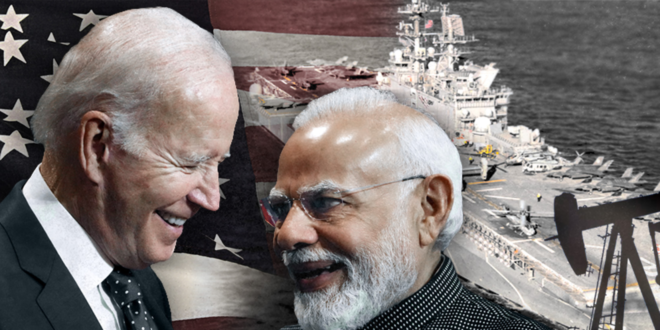New Delhi’s inclination towards the Atlanticist core contradicts its position as a self-reliant economic and military force, and hinders its aspirations for Eurasian integration through collaboration with China and Russia.
In an era marked by shifting geopolitical dynamics and strategic realignments, India’s evolving role as a “supplying and maintenance agent” for the US naval force in the Asia-Pacific region raises questions about the country’s cherished principle of “strategic autonomy.”
As India deepens its alignment with the US, an agreement made late last month between Prime Minister Narendra Modi and President Joe Biden during the former’s state visit has garnered attention. This agreement entails providing base facilities, repairs, and maintenance services for US Navy vessels operating in the Asia-Pacific.
However, this new development is not without its implications, as it potentially conflicts with Chinese interests in the region and could strain India’s relationships with its fellow BRICS members and those of the Shanghai Cooperation Organization (SCO), whose latest fully-fledged member is Iran.
It has been reported that Modi and Biden reached the agreement in order to counter China’s naval influence in the Asia-Pacific region where Beijing boasts the world’s biggest numerical strength with about 355 ships and submarines.
The US Navy’s Indian expansion
Insights into the agreement reveal that the US Navy plans to establish three maintenance and repair hubs in the Indian cities of Chennai, Mumbai, and Goa. In the past, the US has signed bilateral hub agreements in different regions, including West Asia, Western Pacific, Japan, and Singapore.
Quoting a former commander of the US Asia-Pacific Command, Nikkei reported that the US Navy currently conducts operations from Diego Garcia and Western Australia. However, the establishment of maintenance, repair, and logistics hubs in the Indian Ocean would significantly enhance the operational flexibility of the US Navy in the vast Indian Ocean region.
Speaking to The Cradle, a source within Pakistan’s Foreign Office says: “The potential ramifications of establishing US military installations within the Indian Ocean region are such that they may engender a notable level of instability within the vicinity.”
The source adds that the recent development gives rise to apprehensions regarding the SCO’s capacity to effectively accomplish its core objectives, particularly the advancement of regional tranquility and the safeguarding of security.
Declining oil imports from Russia
The progressive shift in New Delhi’s partnership with Washington transcends its traditional focus on defense and technological hardware. Recent developments indicate a deepening camaraderie between the two countries, extending to the procurement of petroleum from the United States, which has displaced Russia as a key oil supplier to India.
These oil purchases signify a significant upswing in the bilateral relationship, resulting in India’s resurgence as a dominant player in the global market. Conversely, there are signs of a decline in crude oil imports from Russia.
Energy intelligence company Vortexa reports an 6.5 percent decrease in India’s crude oil imports from Russia in June compared to the previous month, primarily due to voluntary production restrictions implemented by Russia, the world’s second-largest crude oil producer. In June, India imported 1.8 million barrels per day (mb/d) of crude oil from Russia, down from the record high of 1.96 mb/d in May.
In January 2023, India purchased 406,000 barrels per day (bpd) from the US, which subsequently declined to 244,000 bpd the following month, and further plummeted to 100,000 bpd in March. However, imports from the US saw a rebound, reaching 119,000 bpd in April and 138,000 bpd in May, with a notable 62 percent increase to 224,000 bpd in June.
India’s non-alignment posture
To date, India has adeptly maintained a delicate balance in its relations with western countries and the SCO. As India strives to augment its global and regional influence and position itself as a leader within the Global South, it looks to establish a well-calibrated foreign policy that encompasses major global powers such as the US, China, and Russia, to optimize its national interests.
Some analysts contend that India is now encountering difficulties in integrating into the SCO due to the significant foreign policy pivot the US. The recent strategic defense agreements signed by Modi in Washington have arguably made New Delhi less enthusiastic about multipolarity and regional integration.
It has been suggested that India harbors concerns regarding the dominance of countries such as China and Russia within the SCO, which are perceived as adversaries of the US. India understands that the policies of the SCO could potentially conflict with those of the western nations over the years, with whom New Delhi has recently revitalized its ties.
Delhi’s dilemma
However, Dr Sameer Patil, a senior fellow at Observer Research Foundation (ORF) in Mumbai and a researcher on India’s national and regional security priorities and counterterrorism tells The Cradle that the recent visit of Prime Minister Modi has shed light on the nature of agreements signed by the US and India, highlighting their emphasis on emerging technologies and economic exchanges:
“India’s foreign policy is based on the idea of ‘strategic autonomy’ and includes diplomatic ties with both the US and the SCO. Hence, characterizing India as ‘sitting on the fence’ or in a state of indecision or neutrality would inaccurately portray its stance.”
Dr Patil further argues that it is imperative to analyze the parameters of Indian foreign policy from distinct perspectives, taking into consideration its regional and global responsibilities:
“From my angle, it can be contended that the examination of India’s diplomatic engagements with the US and the SCO should be approached using separate frameworks. India regards the SCO as highly significant in its endeavors to establish and sustain connections with the Central Asian Republics.”
He adds that it is reasonable for New Delhi to continue its involvement with Central Asian nations due to the convergence of interests and shared perceptions of threats concerning regional security.
Nevertheless, Patil emphasizes the significance of taking into account India’s relationship with the US within a broader global framework, explaining to The Cradle that “The strategic partnership between India and the US holds great significance, as it not only contributes to regional stability but also plays a crucial role in ensuring global security.”
India’s gains from the SCO
India’s accession to the SCO in 2017 has spurred its focus on enhancing cooperation with neighboring countries within the organization’s framework. As the world’s fifth-largest economy, India is strongly motivated to strengthen its ties with the SCO to fuel long-term economic growth and address geopolitical and economic risks on a global scale.
Since joining the SCO since years ago, India has witnessed substantial growth in its economic and trade collaborations with Russia, China, and other member states. Trade between Russia and India saw a remarkable increase of approximately 120 percent in 2022 prior to the SCO summit in Shanghai.
Bilateral trade between China and India surpassed the $100 billion milestone in 2021 and continues to exhibit robust growth. Additionally, trade between India and Central Asian countries nearly doubled to reach $2.7 billion during the fiscal year 2019-20.
Following the end of the Cold War, India underwent a significant transformation in its diplomatic relations with the US while simultaneously strengthening ties with Beijing and Moscow to safeguard its strategic autonomy.
However, New Delhi could not optimize the SCO’s capabilities and effectively advance its objectives during its presidency of the organization. It also encountered obstacles in addressing historical frictions, building trust among member nations, and actively participating in nonviolent collaboration on security matters.
Regional hegemon or client state?
In the past 15 years, India has become a member of four multilateral organizations, with two distinct groups emerging: western organizations such as the G20 and the Quadrilateral Security Dialogue (Quad), comprising the US, Australia, Japan, and India; and non-western organizations like the SCO and BRICS, including Brazil, Russia, India, China, and South Africa.
This approach signifies New Delhi’s pursuit of an autonomous foreign policy, striking a delicate equilibrium in its relationships with major global powers while avoiding entanglement in bloc politics.
However, sustaining this equilibrium may become increasingly challenging as Great Power polarization intensifies. Geopolitical tensions between Atlanticists and Eurasianists are on the rise, potentially exerting pressure on India to realign its geopolitical stance in favor of the western powers.
India is anticipated to encounter difficulties in maintaining a fragile balance, given the expected rivalry between the US and China, historical tensions with China and Pakistan, and the robust alliance between the latter two.
These factors pose significant limitations to India’s ability to effectively navigate its position. Moreover, the alignment of interests between China and Russia possesses the capacity to detrimentally affect Indian interests within the region.
 Eurasia Press & News
Eurasia Press & News



